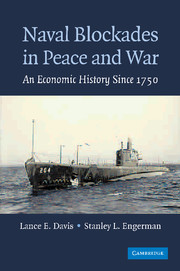Book contents
- Frontmatter
- Contents
- Preface
- 1 Introduction: “Thou Shalt Not Pass”
- 2 Britain, France, and Napoleon's Continental System, 1793–1815
- 3 The United States versus Great Britain, 1776–1815
- 4 The North Blockades the Confederacy, 1861–1865
- 5 International Law and Naval Blockades during World War I: Britain, Germany, and the United States: Traditional Strategies versus the Submarine
- 6 Legal and Economic Aspects of Naval Blockades: The United States, Great Britain, and Germany in World War II
- 7 The American Submarine and Aerial Mine Blockade of the Japanese Home Islands, 1941–1945
- 8 Blockades without War: From Pacific Blockades to Sanctions
- 9 Blockades, War, and International Law: What It All Means
- Conclusion
- Index
Conclusion
Published online by Cambridge University Press: 18 August 2009
- Frontmatter
- Contents
- Preface
- 1 Introduction: “Thou Shalt Not Pass”
- 2 Britain, France, and Napoleon's Continental System, 1793–1815
- 3 The United States versus Great Britain, 1776–1815
- 4 The North Blockades the Confederacy, 1861–1865
- 5 International Law and Naval Blockades during World War I: Britain, Germany, and the United States: Traditional Strategies versus the Submarine
- 6 Legal and Economic Aspects of Naval Blockades: The United States, Great Britain, and Germany in World War II
- 7 The American Submarine and Aerial Mine Blockade of the Japanese Home Islands, 1941–1945
- 8 Blockades without War: From Pacific Blockades to Sanctions
- 9 Blockades, War, and International Law: What It All Means
- Conclusion
- Index
Summary
Blockades have been used primarily as wartime measures to reduce the military power of foes, and they have been employed by both sides of the conflict to seek an advantage. During the conflict, blockades tend to become more inclusive in terms of the definition of contraband, including attempts to limit foodstuffs in order to weaken civilian consumption. Nevertheless, their success rate does not seem very high, because of difficulties of enforcement, the willingness of neutrals to trade with belligerents, and the difficulties when land access to one of the belligerents would be possible. Military strength and productive capacity play a more important role in the outcome of war, and the blockade will end when the war is over.
More recently, blockades have been deployed in an attempt to substitute for war, to attempt to coerce certain nations to meet the behavioral requirements of other nations or groups of nations. Such peacetime, or Pacific, blockades, tended to be imposed by strong nations against weaker nations, and they tend to be more limited in the definition of contraband. Such blockades have ceased either when success was achieved, or when the imposing nations feel that little further is to be gained by continuing. These blockades, too, have not been overly successful, as trade with nations not involved in blockading often continues, and world public opinion may limit the effectiveness of the blockade because of the adverse impacts on the population.
- Type
- Chapter
- Information
- Naval Blockades in Peace and WarAn Economic History since 1750, pp. 427 - 428Publisher: Cambridge University PressPrint publication year: 2006



